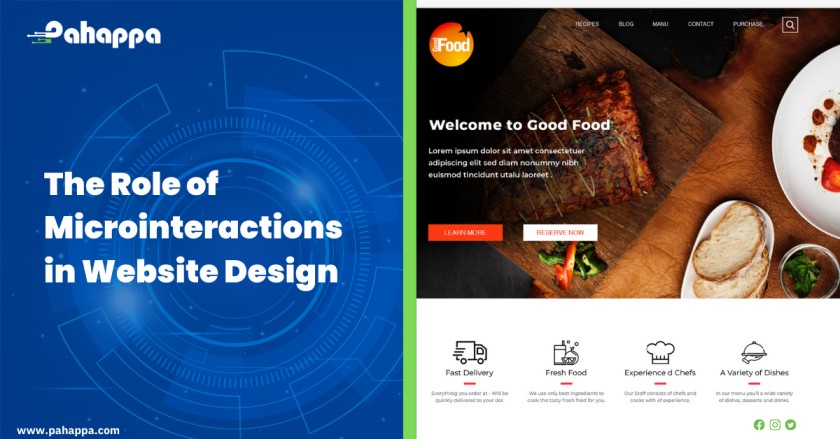In the ever-evolving landscape of web design, where user experience reigns supreme, the smallest details hold the greatest potential. Welcome to a world where every click, hover and scroll matters – a world where microinteractions take center stage. In this article, we delve into the role of microinteractions in website design, transforming websites into immersive experiences that users will remember long after they’ve closed their browsers.
What are Microinteractions in Website Design?
Microinteractions in website design refer to the subtle, small-scale interactions that occur between users and websites. They are the intricate details that enhance the overall user experience by providing feedback, guidance, and engagement throughout the user’s journey. These interactions can be found in various elements of a website, such as buttons, menus, forms, sliders, notifications, and more.
Microinteractions are typically brief, focused, and goal-oriented, serving a specific purpose within the website’s functionality. They can be as simple as a hover effect that highlights a clickable element or as complex as a multi-step form with real-time validation. These interactions often involve visual cues, animations, sounds, or tactile feedback to provide users with immediate and meaningful responses to their actions.
Types of Microinteractions in Web Design
- Hover Effects
These microinteractions occur when a user hovers their cursor over an element on the website. It can involve changing colors, displaying additional information, or revealing interactive elements. Hover effects provide visual feedback and encourage users to explore interactive elements.
- Button Animations
Microinteractions in the form of button animations add interactivity and responsiveness to buttons. They can include subtle transformations, transitions, or loading indicators that visually indicate when a button is clicked or in progress.
- Form Validation
Microinteractions in form validation provide real-time feedback to users as they fill out forms. It can involve displaying error messages when input is invalid or displaying success messages when the input is valid, helping users correct errors and ensuring accurate submissions.
- Notifications and Alerts
These microinteractions inform users of important updates or events. They can include pop-up notifications, alert badges, or subtle animations to draw attention to new messages, notifications, or system updates.
- Content Loaders
Microinteractions in content loaders provide visual feedback during loading processes. They can include progress bars, spinners, or animated graphics that indicate the loading progress, reducing user frustration by keeping them informed about ongoing processes.
- Sliders and Carousels
Microinteractions in sliders and carousels enable users to navigate through content or images. They can include smooth transitions, autoplay options, or navigation indicators that allow users to interactively explore the content.
- Toggle Switches
These microinteractions enable users to switch between different states or options. Toggle switches provide immediate visual feedback to indicate the current state, such as on/off switches, checkboxes, or radio buttons.
- Scroll Animations
Microinteractions in scroll animations bring elements to life as users scroll through a webpage. It can involve parallax effects, fading in or out of content, or transforming elements based on scrolling position, creating a dynamic and engaging experience.
- Feedback and Confirmation
Microinteractions for feedback and confirmation provide users with immediate responses to their actions. It can include subtle sounds, visual confirmations, or animated feedback to acknowledge user interactions, reinforcing engagement and providing a sense of control.
- Micro-Gestures
These microinteractions involve small, subtle gestures that allow users to perform specific actions. Examples include swipe gestures to reveal hidden content, pinch-to-zoom for images, or drag-and-drop interactions for rearranging elements.
Role of Microinteractions in Website Design
- Enhancing Usability and Functionality
Microinteractions improve usability by offering visual cues and feedback that aid users in understanding how the website works. For example, when a user hovers over a button and it changes color or displays a tooltip, it signals that the button is clickable and provides additional information. Microinteractions also help prevent errors by validating form inputs in real-time or displaying error messages when necessary. By incorporating these microinteractions, designers ensure that users can easily navigate and interact with the website, leading to a smoother and more efficient user experience.
- Fostering User Engagement
Microinteractions inject interactivity and playfulness into the website, capturing and sustaining user interest. For instance, a subtle animation when hovering over an image or an interactive slider that responds to user input creates an engaging and immersive experience. These microinteractions encourage users to explore different features, interact with the content, and spend more time on the website. By keeping users engaged, microinteractions enhance their overall satisfaction and encourage them to return for future visits.
- Creating Delightful Experiences
Microinteractions can be designed to surprise and delight users, leaving a lasting positive impression. For example, a whimsical loading animation or a cleverly designed error message can add a touch of personality and charm. By incorporating delightful microinteractions, designers can evoke positive emotions, enhance brand perception, and create memorable experiences that users are likely to share and remember.
- Guiding User Behavior
Microinteractions serve as subtle guides, assisting users in understanding how to navigate and interact with the website. For instance, when a user hovers over a menu item and a sub-menu smoothly expands, it indicates the available options and guides the user’s attention. Microinteractions can also provide feedback during complex processes, such as a progress bar during a multi-step form, ensuring users understand their progress and encouraging them to complete the task. By providing clear guidance, microinteractions reduce confusion and empower users to explore and interact with confidence.
- Communicating Information
Microinteractions offer a concise and visually appealing way to communicate important information to users. For instance, a notification badge that displays the number of unread messages or a subtle animation to indicate a successful action communicates valuable information without overwhelming the user. These microinteractions enable users to quickly grasp relevant information, keeping them informed and engaged without disrupting their browsing experience.
- Feedback and Validation
Microinteractions provide instant feedback to users, confirming their actions and validating their inputs. For example, when a user submits a form, a microinteraction can display a success or error message if the submission was unsuccessful. These real-time responses help users understand the outcome of their actions, reducing uncertainty and providing a sense of control.
- Branding and Personality
Microinteractions offer an opportunity to infuse the website with the brand’s personality and style. By incorporating unique animations, sound effects, or visual cues, designers can create a cohesive brand experience. These microinteractions contribute to brand recognition and differentiation, making the website stand out and leave a lasting impression on users.
- Encouraging Desired User Behavior
Microinteractions can be used strategically to encourage specific user behaviors or actions. For instance, a subtle animation or a reward system for completing certain tasks can incentivize users to explore more, sign up for newsletters, or share content on social media. By designing microinteractions that align with the website’s goals, designers can guide users toward desired actions and conversions.
- Accessibility and Inclusivity
Microinteractions can greatly enhance accessibility features on websites. For users with visual impairments, microinteractions can include descriptive alt text or ARIA attributes to provide meaningful descriptions of interactive elements. Additionally, microinteractions can support keyboard navigation and provide focus indicators, ensuring that users who rely on assistive technologies can fully engage with the website.
- Continuous Improvement and Iteration
Microinteractions allow designers to gather valuable user feedback and analytics. By monitoring how users interact with different microinteractions, designers can identify areas of improvement, refine the user experience, and iterate on the design. This iterative process ensures that microinteractions evolve to meet users’ changing needs and preferences over time.
So, let us embrace this world of microinteractions where the smallest actions carry profound impact. Remember that every click, hover, and scroll is an opportunity to immerse users in a captivating journey. The potential of microinteractions, can shape websites that linger in users’ memories long after they’ve closed their browsers, paving the way for a future where the art of web design continues to evolve and thrive. Contact us today to get started!











